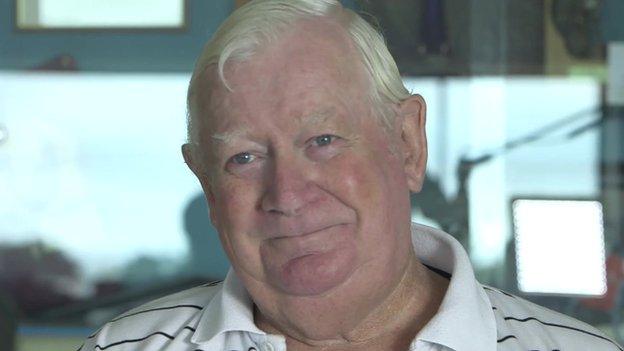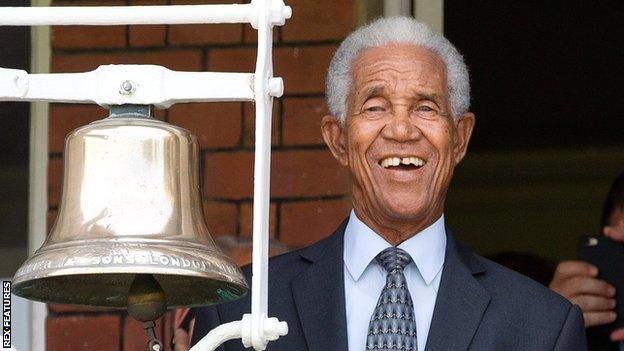Malcolm Nash: The Glamorgan bowler on the end of Sir Garfield Sobers' six sixes
- Published
What was it like for the man bowling in Sir Garry Sobers' historic six sixes in an over?
Every sport has its defining moments. One of cricket's most famous days came on 31 August, 1968.
Sir Garfield Sobers famously became the first batsman to hit six sixes in an over in a first-class cricket match in Swansea.
The legendary West Indies all-rounder was playing for Nottinghamshire against Glamorgan at St Helen's and his bowling victim was Welsh bowler Malcolm Nash.
Half a century on, Nash is back at the St Helen's venue on the Swansea coastline, which he now lives only a few miles from, to recall what happened that famous day.
"It won't be different to the other 49 years," Nash told BBC Sport Wales.
"I have not changed my story in the last 50 years about what I was trying to do.
"When you are playing against the best player of all time, all you want to do is try and get him out and that is what I tried to do.
"Other bowlers have been struck for six sixes, but have not had the same attention.
"It was five minutes of my life that has been talked about now for 50 years."

Things had started all so well on that first day of the county championship match for Nash after reverting to spin from his traditional seam bowling.
"It was the time of day where we were trying to get some wickets and they were trying to get some quick runs for a declaration," said Nash.
"I had bowled seam earlier in the day and captain Tony Lewis had asked me before tea to relieve Peter Walker and bowl some orthodox left-arm spin.
"I got four wickets doing that and at one time my figures were looking good.
"When Garry came to the wicket after tea he bludgeoned that to death."
Sobers arrives
That arrival of Sobers to the crease changed everything.
"It was the first time I had played against him in a first-class game and he was so dynamic," said Nash.
"When you look at specialist all-rounders through history, nobody can lace his boots.
"I never thought about him getting six sixes at all during the over. I just thought about getting him out and taking five wickets myself.
"He hit them all pretty cleanly except one.
"The second ball was pretty dramatic. It nearly destroyed the [nearby] pub after hitting the guttering.
"It went like a tracer bullet and was still going up when it hit the building."
The first four balls came and disappeared over the boundary ropes before Nash thought he had his man.
Archive: Garfield Sobers' six sixes - relive the achievement from 1968
"I gave the fifth ball a little bit more air and Garry got underneath it," he said.
"Roger Davis was underneath it at long-off and caught it and fell on his backside and landed on the line.
"There was a little controversy about which side of the line he landed. Umpire Eddie Phillipson, much to the delight of the crowd and my colleague Tony Cordle, signalled six. That was that.
"The previous year the rule was if you caught the ball inside the boundary and went over it was out.
"They changed the ruling in 1968 to say it was six before going back to the original ruling the year after. Funny really."
Super six
History then beckoned despite Nash trying to stop it.
"There has been lots of talk whether Tony Lewis spoke to me, but if you look at the footage the only person who is close to me is John Parkin, the non-striker, umpire Phillipson and Sobers himself," he recalled.
"I bowled the same run-up and action, but I bowled a seamer which proved an absolute disaster.
"It was a half tracker and he despatched it to a bus stop down the road."
The crowd were elated, but what about the bowler who had just been struck for 36 in one over and saw his final ball disappear out of the ground?
"I was a little numb immediately after the last ball," said Nash.
"The fact it was a world record and history was made did not register.
"They declared and we walked off together and we were both smiling.
"I said he should buy me a couple of beers that evening because he could not have done it without me.
"We went over to do a BBC interview at the end of the days play and I told Garry "this world record could not have been done without me."
Nash was only 23 at the time, but refused to let the over affect his impressive career which included 993 first-class wickets.
He had helped Glamorgan defeat Australia earlier in 1968 and went on to help the Welsh team win the county championship in 1969.

Sir Garfield Sobers rings the afternoon bell during the England v Sri Lanka Test at Lord's in June, 2016
Nash went on to feature in Glamorgan's first one-day final in 1977 and captain the county before his final first-class game in 1983.
"It did not define the rest of my career; if anything it gave me greater resolve," said Nash.
"I could have easily have said I was done with cricket and never picked up a ball ever again.
"That was not in my nature. My record speaks for itself and I got top players out on a regular basis.
"I knew I could bowl. I just did not bowl slow, orthodox left-arm again for a long time!"
Wrong ball?
Nash moved to north America after finishing his career, but returned to public spotlight in 2006 when a ball claimed to be, external the one used at St Helen's was sold for £26,400 at auction.
A subsequent re-sale in 2012 was dropped because of questions over its authenticity, amid suggestions Sobers had inadvertently given a supporter the wrong ball, decades previously.
Nash has always been adamant the ball sold at auction was the wrong one.
"Firstly, contrary to what has been said we had not run out of balls, we used the same ball for all six deliveries," said Nash.
"That last ball came back the following day from a lad who had picked it up on his way home to Neath.
"The ball I bowled that day and always bowled for Glamorgan was a 'Stuart Surridge'.
"I was in living in north America when one of my colleagues, Peter Walker, rang me and said they were auctioning the ball I bowled.
"When he mentioned it was a 'Dukes' ball I told him we always used a 'Surridge' ball.
"He said he would get onto Christies and they gave him short shrift believing they had done their due diligence.
"They sold the wrong ball and they won't speak to me about it despite me trying on numerous occasions. They say the matter is closed."
Still good friends
This matter has not affected his relationship with the man that he created history with 50 years ago.
"Our relationship has been good over the years and we have never lost touch," said Nash.
"I met with him this summer. Like me, he is getting a bit more frail, but is in good humour.
"We did not talk much about the over, everywhere we go it is all anybody wants to talk about.
"We did other things in our lives and experienced events which were important.
"We get a little bit bored of it from time to time.
"I have done a book this year which tells the rest of my cricket life. I bowled about 11,000 overs so around 10,999 overs are in the book.
"That one over, as I say. It was just five minutes of my life."